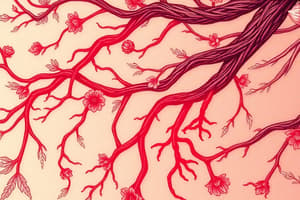Podcast
Questions and Answers
What is one of the earliest manifestations of acute inflammation?
What is one of the earliest manifestations of acute inflammation?
- Endothelial injury
- Vascular leakage
- Leukocyte margination
- Vasodilatation (correct)
What primarily causes the increased vascular permeability during inflammation?
What primarily causes the increased vascular permeability during inflammation?
- Increased blood viscosity
- Contraction and relaxation of smooth muscle
- Reduction of blood flow
- Endothelial cell contraction and injury (correct)
What effect does vasodilatation have on blood flow?
What effect does vasodilatation have on blood flow?
- Causes localized redness and heat (correct)
- Decreases blood flow in arterioles
- Induces blood coagulation
- Reduces the concentration of red blood cells
Which mediator is primarily responsible for causing vasodilatation?
Which mediator is primarily responsible for causing vasodilatation?
What is the result of stasis in small blood vessels during inflammation?
What is the result of stasis in small blood vessels during inflammation?
What is the primary function of lipoxins in the context of inflammation?
What is the primary function of lipoxins in the context of inflammation?
Which cells are primarily induced to produce TNF?
Which cells are primarily induced to produce TNF?
What causes the production of IL-1 in various cells?
What causes the production of IL-1 in various cells?
How does TNF influence macrophage responses?
How does TNF influence macrophage responses?
What overall systemic effect is associated with TNF and IL-1 during inflammation?
What overall systemic effect is associated with TNF and IL-1 during inflammation?
In terms of leukocyte recruitment, what is a primary role of endothelial activation?
In terms of leukocyte recruitment, what is a primary role of endothelial activation?
Which inflammatory stimuli are known to induce TNF production?
Which inflammatory stimuli are known to induce TNF production?
What role does IL-1 play in relation to fibroblasts during inflammation?
What role does IL-1 play in relation to fibroblasts during inflammation?
What is the primary function of inducible nitric oxide synthase (iNOS)?
What is the primary function of inducible nitric oxide synthase (iNOS)?
Which type of lysosomal granules in neutrophils primarily contains myeloperoxidase (MPO)?
Which type of lysosomal granules in neutrophils primarily contains myeloperoxidase (MPO)?
What is the potential cause of tissue injury by activated leukocytes during inflammation?
What is the potential cause of tissue injury by activated leukocytes during inflammation?
What role do antiproteases play in the context of leukocyte-mediated tissue injury?
What role do antiproteases play in the context of leukocyte-mediated tissue injury?
What can trigger 'frustrated phagocytosis' in macrophages?
What can trigger 'frustrated phagocytosis' in macrophages?
In what situation is leukocyte-mediated tissue injury considered a normal defense mechanism?
In what situation is leukocyte-mediated tissue injury considered a normal defense mechanism?
Which of the following is NOT a component found in the primary granules of neutrophils?
Which of the following is NOT a component found in the primary granules of neutrophils?
What can be a consequence of the excessive response of leukocytes to environmental substances?
What can be a consequence of the excessive response of leukocytes to environmental substances?
What type of chemokines predominantly attract monocytes, eosinophils, basophils, and lymphocytes?
What type of chemokines predominantly attract monocytes, eosinophils, basophils, and lymphocytes?
Which complement protein activation process is considered critical in the complement system?
Which complement protein activation process is considered critical in the complement system?
Which leukocyte types are mainly targeted by C-X-C chemokines like IL-8 (CXCL8)?
Which leukocyte types are mainly targeted by C-X-C chemokines like IL-8 (CXCL8)?
What role do homeostatic chemokines play in the immune system?
What role do homeostatic chemokines play in the immune system?
What is the primary function of the complement system?
What is the primary function of the complement system?
How do chemokines primarily exert their effects on target cells?
How do chemokines primarily exert their effects on target cells?
Which of the following best describes the role of inactive complement proteins?
Which of the following best describes the role of inactive complement proteins?
What is the most notable effect of complement proteins in the immune response?
What is the most notable effect of complement proteins in the immune response?
What is characterized by granulomas formed from aggregates of activated macrophages and is often associated with T lymphocytes?
What is characterized by granulomas formed from aggregates of activated macrophages and is often associated with T lymphocytes?
Which type of granuloma is caused by non-immunogenic foreign bodies?
Which type of granuloma is caused by non-immunogenic foreign bodies?
What type of granuloma is often associated with a persistent T-cell mediated immune response?
What type of granuloma is often associated with a persistent T-cell mediated immune response?
Which staining technique is important for identifying acid-fast bacilli in granulomatous inflammation?
Which staining technique is important for identifying acid-fast bacilli in granulomatous inflammation?
In granulomas, which type of cell may fuse to form multinucleated giant cells?
In granulomas, which type of cell may fuse to form multinucleated giant cells?
What type of necrosis is commonly associated with Granulomas seen in Mycobacterium tuberculosis infection?
What type of necrosis is commonly associated with Granulomas seen in Mycobacterium tuberculosis infection?
Which granulomas do not show a surrounding collar of lymphocytes and are often categorized as non-caseating?
Which granulomas do not show a surrounding collar of lymphocytes and are often categorized as non-caseating?
What is a key factor in recognizing granulomatous inflammation and distinguishing it from other conditions?
What is a key factor in recognizing granulomatous inflammation and distinguishing it from other conditions?
Flashcards are hidden until you start studying
Study Notes
Inflammation and Vascular Changes
- Inflammatory fluid can be either exudate or transudate.
- Vasodilatation is an early sign of acute inflammation, starting with arterioles and extending to capillary beds.
- Histamine and other mediators trigger vasodilatation, leading to increased blood flow, heat, and redness (erythema).
- Increased vascular permeability causes fluid leakage, contributing to vascular congestion and localized redness.
- Blood leukocytes, especially neutrophils, marginate along the endothelium and migrate into the interstitium.
Vascular Permeability Mechanisms
- Increased permeability results from endothelial cell contraction and injury.
- Contraction is a transient response (15-30 minutes) caused by mediators like histamine and leukotrienes, creating interendothelial gaps.
- Endothelial injury is immediate and sustained, often from direct physical damage or microbial activity.
- Neutrophils release lysosomal enzymes (e.g., MPO, lysozyme) to degrade bacteria and debris; macrophages also release similar enzymes.
Leukocyte-Mediated Tissue Injury
- Activated leukocytes can injure tissues in different scenarios: defense against infections, autoimmune responses, and allergies.
- Damage may result from the release of phagolysosome contents, especially in "frustrated phagocytosis."
- Antiproteases in serum help mitigate tissue damage caused by leukocyte activity.
Cytokines and Chemokines in Inflammation
- TNF and IL-1 are critical cytokines produced by macrophages, mast cells, and other cells, inducing localized and systemic inflammatory responses.
- Activation of endothelial cells enhances leukocyte recruitment and increases procoagulant activity.
- Chemokines, produced by leukocytes and macrophages, direct leukocyte movement (chemotaxis) and activate specific leukocyte types.
- Specific chemokines include C-X-C for neutrophils and C-C for monocytes and eosinophils.
Complement System
- Complement proteins, synthesized in the liver, are vital for innate and adaptive immunity against pathogens.
- Activation of complement leads to vasodilation, leukocyte chemotaxis, and direct microbial killing.
- Key processes involve the cleavage of complement proteins like C3, initiating the enzymatic cascade critical for immune response.
Granulomatous Inflammation
- Characterized by granulomas, which consist of aggregates of activated macrophages, T lymphocytes, and sometimes necrosis.
- Granulomas form as a response to difficult-to-eradicate agents and can be classified into:
- Foreign body granulomas: Induced by non-immunogenic materials (e.g., sutures).
- Immune granulomas: Triggered by persistent microbes with a T-cell mediated immune response (e.g., tuberculosis).
- Sarcoid granulomas: Have an unknown cause and are typically non-caseating.
- Recognizing granulomas is essential for excluding treatable conditions like tuberculosis; diagnostic methods include special staining and cultures.
- Microscopic examination shows epithelioid histiocytes and possible caseous necrosis, especially in tuberculosis.
Studying That Suits You
Use AI to generate personalized quizzes and flashcards to suit your learning preferences.



